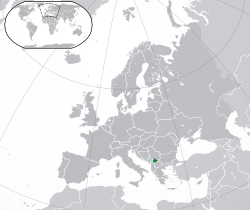Kosovo
Kosovo (Albanian: Kosova, Serbian: Kосово и Метохија, Kosovo i Metohija) is a largely mountainous country in South Eastern Europe. It declared independence from Serbia in February 2008 but Serbia has not recognised it. Kosovo borders Albania from the west, Montenegro from the northwest, North Macedonia from the south, and Serbia to the northeast.
In 2019, Kosovo is recognised by about slightly over half of the countries around the world. Serbia and some other countries continue to consider Kosovo an "illegitimately separated province". The majority of the population is ethnic Albanian. Minorities include Serbs, Bosniaks, Turks, Gorani and Roma (all five of which are considered equal in status to Albanians within Kosovo's constitution). Most Albanians, as well as Turks, are Muslim, but the regime is secular, and all religious groups freely observe their key feasts and celebration dates.
Kosovo is also young in terms of average age of population, with more than 70 percent of its population under the age of 35.
|
While the independence of Kosovo is disputed by some states, from a traveller's perspective it is the self-proclaimed state which exercises de facto control of the land. |
Regions
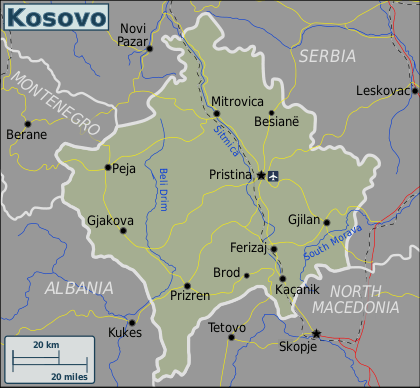
| Central Kosovo Contains the capital Pristina, which has a lively downtown with bustling cafes and bars, galleries and museums, the Newborn independence monument and the Germia National Park right on the edge of the city. Cultural events are hosted here year-round and it has regular transport links to towns and cities throughout Kosovo. Outside of the city, lies the town of Gračanica with its 14th century Serbian Orthodox monastery and nearby Ulpiana archaeological site. The region also includes two monuments to the Battle of Kosovo in 1389, a tower at Gazimestan and the Tomb of Sultan Murad. |
| Western Kosovo The west is Kosovo's most scenic region and has a rich cultural heritage. It's two biggest cities are Peja, with its scenic location and 13th Century UNESCO-protected Patriarchate, and Gjakova with its recently restored Ottoman old town. Behind Peja lies the dramatic Rugova Gorge, a national park and playground for outdoor activities, while east of Gjakova is wine-making country, with vineyards surrounding the town of Rahovec. Serbian heritage can be explored in the medieval village of Velika Hoca, where rakija (brandy) is still made in the traditional way, and the Visoki monastery with its 14th century original frescoes just outside of Dečan. Two sets of waterfalls in the west can offer a refreshing getaway, including Mirusha on the road from Prishtina to Gjakova and Radavc, between Peja and Montenegro, where the source of the White Drin can be found. |
| Southern Kosovo The city of Prizren lies at the heart of southern Kosovo, with its historic old town, hilltop castle, and impressive array of mosques and churches. South of Prizren is the remote mountainous area of Dragash, home to one of the Balkans' most picturesque villages, Brod. The Sharri mountains stretch across Kosovo's southern border, and offer ample opportunities for hiking and skiing, on the slopes of Brezovica. |
| Northern Kosovo At the centre of the northern region is the city of Mitrovica, with its mixed Albanian and Serb population divided by the River Ibar. Nearby is the town of Vushtrri, the oldest settlement in Kosovo that has a centuries old castle and stone bridge. At Prekaz, close to Skanderaj, visitors can get a glimpse into Kosovo's more recent history, at a monument to the Jashari family, whose massacre in 1998 is often seen as the trigger to the escalation of violence at the end of the 20th century. Opportunities for hiking are provided by rural regions in the north, including in Shala e Bajgores east of Mitrovica and around the lake outside of Zubin Potok. |
| South-eastern Kosovo The rolling hills of Kosovo's southeast are home to the bustling city of Gjilan, a medieval fortress at Novo Brdo and the church where Mother Theresa received her calling at Letnica. On the road from Prishtina to Skopje lie the cities of Ferizaj and Kacanik, with their murals and post-industrial heritage, and a chance to explore the Gadime caves. |
Other destinations
Understand
History

History in Kosovo has been highly politicized and is wrapped up with the histories of its Balkan neighbors.
Control of Kosovo changed hands many times in the medieval period, passing variously from being part of the Bulgarian Empire, Byzantine Empire and the Serbian Empire. From the 15th century Kosovo was part of the Ottoman Empire for almost 500 years, before the empire collapsed at the beginning of the 20th century. Wars and border disputes continued as Kosovo became part of the Kingdom of Serbia, which expanded into the Kingdom of Serbs, Croats and Slovenes at the end of World War I, and changed its name to the Kingdom of Yugoslavia in 1929.
At the end of World War II, and the defeat of the invading Axis powers by socialist partisans, Kosovo became an Autonomous Province in the Socialist Federal Republic of Yugoslavia, led by Josip Broz Tito.
After Tito's death in 1980, and the rise of nationalism throughout Yugoslavia, Kosovo was stripped of its autonomous status at the end of the '80s by the regime of autocratic leader Slobodan Milosevic. With Yugoslavia breaking apart, Kosovo's Albanians were stripped of many of their rights during a decade of repression during the 1990s, which ultimately ended in the war of 1998-99, as Kosovar Albanians stood up against the Serbian regime to fight for their liberation. A bombing campaign against Serbian military targets brought the war to an end in June 1999, and led to a period in which Kosovo was administered by the United Nations.
On February 17, 2008, Kosovo declared independence from Serbia, and was quickly recognized by many world powers, including the United States and most member states of the European Union. However Serbia continues to refute Kosovo's independent status. It is also not a member of the United Nations as its independence is not recognised by Russia and China, both of whom have used their veto power on the Security Council to block any UN recognition of Kosovo. Domestically, while most ethnic Albanians support Kosovo's independence, most ethnic Serbs do not and still consider Kosovo to be a part of Serbia.
Climate
The climate is continental, with very warm summers and cold and snowy winters.
Religion
Kosovo is a multi-ethnic, secular state whose population practices a diverse selection of religions. The majority Albanian population is mainly Muslim, though with a significant catholic minority. Kosovo's Bosniak, Gorani and Turkish communities are also predominantly Muslim, while Kosovar Serbs tend to practice Serbian Orthodox Christianity.
Get in
 |
Visa restrictions:
Serbia
|
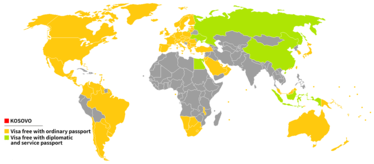
Citizens of countries such as Albania, Australia, Canada, the European Union, CIS, Lebanon, Malaysia, Singapore, South Africa and Turkey do not need a visa, but if you are planning to stay in Kosovo for more than 90 days you should register at the Police Department for the Registration of Foreigners. This is next to the central police station in Pristina. Citizens of other countries that have significantly contributed to the rebuilding of the Kosovo probably also do not need visas either, although Kosovo is starting to implement a stricter visa regime. The 90-day rule for the registration of foreigners applies to everybody .
You can enter Kosovo through the northern border with Serbia through Kosovska Mitrovica or near Pristina. There are bus connections from Belgrade and Nis to Pristina and Prizren and from all the major towns in Serbia to the northern parts. The most used transport route is through North Macedonia and Pristina airport. Skopje is only one and a half hour from the capital city of Kosovo, Pristina. Travelling from Pristina to any other city of Kosovo does not take longer than an hour and a half. For instance, from Pristina to Prizren takes 45 minutes. Travelling to Peja takes a hour and a half.
By plane
- 🌍 Pristina International Airport (PRN IATA). Several European airlines have started to offer direct flights from their hubs to the Pristina International Airport. Examples are easyJet, SAS Scandinavian Airlines, Eurowings, Jetairfly, Norwegian Air Shuttle, Turkish Airlines, Pegasus Airlines, SWISS, Edelweiss Air, Croatia Airlines and Austrian Airlines. Adria Airways has a regional hub in Pristina. During the summer, several additional charter flights are available for travellers.
By bus
From Montenegro, you can enter through Rozaje to Peja/Pec (approximately 2.0 hours).
From North Macedonia (Skopje), you can take a bus to Pristina (less than 1.5 h)
There is a border crossing in the Presevo Valley in Serbia.
There are a couple companies offering buses from Istanbul via Skopje.
From Albania, you can enter through Prizren on a nice new road; gone are the days of the "nightmare" 10-hour mountain ride. The trip from Tirane costs 10€ and takes less than 4 hours, with two stops.
By train

There are also trains crossing the Kosovo border. Two daily services connects Kraljevo in Serbia with all towns on the Leshak, Fushë Kosovë (Kosovo Polje). Connections from Beograd are possible but includes a long stay between train at Kraljevo, thus bringing the journey to more than 12 hours for 399 km. This service has vanished from Kosovo Railways' timetable but it is reported that Serbian Railways run a twice daily service from Zvecan (just after Mitrovica) all the way to Kraljevo. Check their homepage for details. No passenger trains run between Fushe Kovove/Kosovo Polje – Mitrovica – Zvecan.
Since March 1, 2006, an identical service, twice daily, has run from Skopje in North Macedonia to Pristina in Kosovo. It is hard to find timings for these trains. Trains are very slow and convey second class only, but they give the opportunity to see a lot of Kosovo and are good value at approximately €4 each way.
This service has been reduced to once daily, leaving Pristina at 7.10, arriving in Skopje at 09.52 (return leaving Skopje at 16:35). The timetable is available at the Kosovo Railways website.
By car
To enter Kosovo, the validity and acceptance of the International Motor Insurance Card is in doubt. At the border you will need to pay for separate insurance, which will cover you throughout Kosovo for two weeks. Costs depend on the vehicle but two weeks' cover is usually under €20. Ensure also that you have your vehicle registration and a power of attorney from the owner if the car is not yours. During the summer holidays in Germany and Switzerland expect long queues at the border crossing in Merdare (up to 3 hours).
Get around
By bus
The best way to travel intercity in Kosovo is by bus. The buses are relatively cheap and comfortable (for example from Pristina to Peja is €4), with discounts available for students. Payment is usually made on the bus to a representative of the bus company coming around once the journey has started - you may or may not receive a physical ticket, depending on the company.
Between some cities you may also have the option of mini-vans, running from nearby the main bus station. These leave when full and are usually a similar price to the regular buses.
By train
There are two daily trains from Pristina to Peja which are a comfortable way to make this journey (€3)
By car

Major construction of highways in recent years has cut travel times between major cities significantly, and more highways are being built and improved.
Driving in Kosovo, particularly in cities, can be a little stressful to begin with, and it can be best to go in with the attitude of "expect the unexpected." Pedestrians crossing in front of you unexpectedly, cyclists coming towards you on the wrong side of the road, and potholes appearing out of nowhere are all familiar sights, as are just-in-time overtaking maneuvers and swerving lane-changes, while roundabouts bring with them their own unique customs. That being said, you are likely to quickly get used to it and as long as you stay alert - and look out for sudden changes in road surfaces - you should be fine!
Parking can be a challenge, particularly in Pristina and major cities, but there are plenty of informal car parks (at around 1-2 euros for the day), where your vehicle should be safe. Lots of locals choose to park up at the side of the road, on pavements, or wherever there are a few square meters, although the police have begun to remove illegally parked vehicles in some areas.
Road signs and place names usually appear in both Albanian and Serbian, although it is not uncommon for the minority language to be scratched out - a useful indication of the majority population of the area you're in.
By taxi
It is best to use registered taxis as they have fixed prices and are metered. Registered taxis are clearly marked with a company name and phone number printed on the vehicle. Unregistered taxis are usually cars with a yellow taxi sign affixed to the roof, they are safe, but the price is entirely at the driver's discretion. For more information on taxi companies see the pages for individual cities.
Talk
Most people in Kosovo speak Albanian, while in Serb-majority areas, such as the north, Serbian is spoken - both are official languages and appear on road signs, etc. All Kosovar Albanians born 1987 or earlier will understand Serbian, although it may result in a hostile reaction if you try to speak Serbian to them.
Young people, particularly in the major cities such as Prishtina and Prizren, are likely to understand English, whereas the older generation are more likely to understand German. Some older people are able to speak Russian, as it was compulsory in schools during the communist era, although it may not be received well among the Albanian population due to its apparent similarity with Serbian.
Turkish can be useful, and the Turkish minority speaks both Turkish and Albanian.
See

- 🌍 Prishtina. is the capital city of Kosovo. Places that should be visited in Pristina is the quarter near the National Museum of Kosova. In addition to visiting the museum where a lot of archaeological artifacts are presented, in both ways when you exit, you see the old mosques from the Ottoman Empire era.
- 🌍 Prizren. The most historical city in Kosovo. It has plenty of examples of beautiful Islamic architecture.
- 🌍 Mirusha Waterfalls (Ujëvarat e Mirushës) (Take the Prishtina - Gjakova bus and ask to be dropped off at Ujëvarat e Mirushës then walk ~3 km inland.). Located between Prishtina and Gjakova, it is a nice hike ending in a cascade of 16 waterfalls and visible stone strata. On the way back stop at the restaurant near the road for fish and relaxation.
- 🌍 Waterfall of the Drini River (Radavc) (Located north of Peja behind the Berdynaj village). During the summer, this place is fantastic, and the road to the river is an amazing, narrow road with wires on one side and the river on the other; this is a great part of Kosovo.
- 🌍 The Pec Patriarchy (The Peć patriarchy lies 2 km to the north west of the Peja (Pec) city center.). This location was the seat of the Patriarchy of the Serbian Orthodox Church starting in 1302 and for many Serbs is considered to be of extreme national importance. All of the Serbs who lived in Peja have either left or been forced to do so by Albanian nationalists leaving the Patriarchy to be heavily guarded by NATO troops, with a few remaining clergy. It is a beautiful monastery with many spectacular paintings. If you go, dress conservatively.
- 🌍 Rugova Gorge (Rugova gorge is also to the northwest of Peja, can be found by following the same road that leads to the Pec Patriarchy. Just drive further.). The canyon has extremely steep walls reaching possibly up to 300 meters.
- 🌍 Gjakova Old Bazaar. A very beautiful old "shopping center" from 17th century. It was burned down during the war in 1999 and has been reconstructed. Also in the center of the bazaar is located an old mosque that was built in the 15th century. It is one of the rarest of its kind. An architectural and cultural complex, with a length of 1 km, including a space of about 35,000m2, it holds a large number of crafts-work shops. free.
- 🌍 The Mitrovica Bridge. An interesting symbol of the division of the population in Kosovo. This bridge is the dividing line between Serbs and Albanians in Mitrovica. It will almost always be safe to approach the bridge and look at it.
- 🌍 Brezovica Ski Centre. Old infrastructure but great slopes, located in Southern Kosova. Go there from Prizren or from Prishtina through Ferizaj.
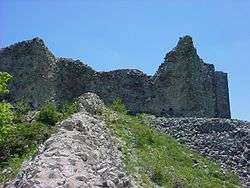
- 🌍 Novobrdo. In Latin documents written as Novaberd, Novus Mons or Novamonte; and in Saxon miners' documents as Nyeuberghe) was mentioned in the historical documents as early as 1326. Novo Brdo was a metropolis at the time, with a huge medieval fortress built on the top of an extinct volcano cone, the remains of which can be visited today, and residential sections sprawling all around. In the outer wall of the fortress, a large cross is visible, built into the stones. The castle, or fortress, was thought at one point to have dated back to the Byzantine Empire.
- 🌍 Ulpiana (from Prishtina, head towards Gracanica, make a right downtown towards Ulpiana). One of the oldest cities in the Balkan peninsula, is 20–30 minutes away from Pristina towards Gjilan. It was re-constructed by Justinian I emperior.
Medieval monuments
A UNESCO World Heritage listing consisting of four religious edifices:
- Gračanica Monastery near Prishtina – One of the most beautiful examples of Serbian medieval (14th c.) ecclesiastical architecture. This monastery was built by the Serbian king Milutin in the Serbo-Byzantine style, reportedly its shape being inspired by a cloud. It is noted for its frescoes, and being the only medieval Serbian monastery found in an urban setting complete with an old school and archives.
- Decani Monastery in western Kosovo – One of the most important monasteries of the Serbian Orthodox Church in Kosovo. It is famous for its elegant and peculiar architecture. As an orthodox monastery from the 13th century, it successfully mixes western and eastern church building elements to form a particular hybrid style only known on the territory of old Serbia. This monastery is particularly noted for some of the world's finest medieval frescoes adorning its walls.
- Monastery of the Patriarchate of Peć in Peja, northwestern Kosovo.
- Our Lady of Ljeviš – in Prizren, southern Kosovo.
Do
Though Kosovo is not yet well known for its tourism, this is changing rapidly and definitely has something to offer for every type of traveler. Surrounded by high mountains and still coming into its statehood, Kosovo is easily accessible in many aspects and one of the cheapest European destinations to travel. With cross-border hiking trails like the Via Dinarica and Peaks of the Balkans bringing an influx of new visitors to Kosovo that can be traversed in a day, but can take years to fully absorb, now is the perfect time to discover the potential of this once-unknown region. Exploring Kosovo's rural areas you will find a land rich in stunning scenery, cultural heritage and exceptional hospitality. Travelers can enjoy hiking over the jagged Sharri, Pastrik and Accursed Mountains, ski pristine and less-trodden slopes in Brezovica, appreciate the well-preserved Ottoman architecture of Prizren, sample raki or homemade wine around Rahovec, visit a traditional stone kulla in Junik or Drenoc, dive into the coffee-drinking culture in one of Prishtina’s many wonderful cafés, or explore both Islam and Orthodox Christianity at beautiful monasteries and mosques (sometimes found side by side) around Kosovo. As a place full of lively cafés and wide-ranging restaurants, a thriving outdoor adventure scene, the warmest locals you can imagine and some of the cheapest prices across a vast region, Kosovo definitely deserves the attention not only of the intrepid traveler, but of anyone looking to avoid the regular tourist traps.
Buy
Money
|
Exchange rates for Euros As of 25 January 2019:
Exchange rates fluctuate. Current rates for these and other currencies are available from XE.com |
Kosovo uses the euro, like several other European countries. One euro is divided into 100 cents. The official symbol for the euro is €, and its ISO code is EUR. There is no official symbol for the cent.
All banknotes and coins of this common currency are legal tender within all the countries, except that low-denomination coins (one and two cent) are phased out in some of them. The banknotes look the same across countries, while coins have a standard common design on one side and a national country-specific design on the other. The latter side is also used for different designs of commemorative coins. The design on the national side does not affect the use of the coin.
In Serbian-majority municipalities
The Serbian dinar is used in the four Serbian-majority municipalities in northern Kosovo and in Gracanica and Strpce. Exchange offices are found almost everywhere. Note that in these locations while euros are accepted generally, all prices are listed in dinar.
Souvenirs
For those seeking a souvenir to take back with them from Kosovo, there are many options available: From fine handcrafted Filigree silver to traditional Albanian wool hats (a plis) and musical instruments (the stringed ciftelia). Local food and drink specialties to take home could include honey, raki, a high strength alcohol distilled from fruit, ajvar, a pepper based spread or feferona, spicy local peppers.
Tipping
In Kosovo generally tipping is not expected from locals, but as it is done by foreigners, it is welcome. In more upmarket venues it might be more likely for tipping to be expected. In taxis you can tip to the nearest euro or half euro.
Eat
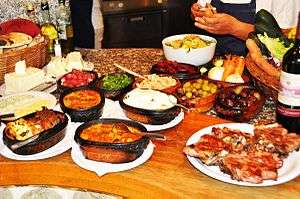
Best restaurants to eat at are those that are located in the villages near by big cities; they tend to have the best meat dishes and the best sea food. Trout, seabass and salmon fish are very common and popular and are kept fresh in their pools and are nearly always fried when you order. Prices are pretty average and, for some countries' nationals, cheap.
Lots of great burek (baked pastry stuffed with cheese, meat or spinach). Try the drinkable yogurt (Ayran)—it's superb. Lots of kebabs and other Ottoman Turkish style food.
As far as you are in an Albanian territory, you could try Albanian food as well. Fli, a very good pastry, can be found in different traditional restaurants.
At the bakery, you can buy a fantastic loaf of bread for under €1.
The grocery stores have a plentiful supply of Western food.
Drink
Alcoholic:
Beer brewed in Peja and named after the city of its origin can be found across Kosovo. Peja Premium is a slightly stronger beer from the same brewery but less widely available. Sabaja is the second beer in Kosovo. It is a home brew beer and it's ale (not pilsner). It is mostly found in Pristina but maybe also in different cities. Other local beers include Pristina and Grembeer.
Kosova was very known for wine production. There are a lot of vineyards Kosovo's south west, with Stonecastle one of the larger wine producers. Even though the Albanians are predominantly of Muslim heritage, attitudes to drinking are quite liberal.
Raki is another alcoholic beverage in Kosova. It is made from local fruits (the most common is from grape, with plum, pear and quince all also regularly available) and can be best described as a hard liquor similar to vodka.
Non-Alcoholic:
Yogurt/Ayran is a common local drink and is often consumed with pastry based foods.
Boza is also another common sweet drink made from cornflour and often drank with cakes and pastries.
Local company Frutomania produce 100% natural juices, alongside traditional fruit drinks like limonata (from lemons) and boronica (from blueberries)
Sleep
Accommodation in Kosovo can be expensive in hotels, but in Pristina, Prizren and Gjakova in particular, cheap accommodation (hostels or apartments) are very easy to find.
Basically you can find:
- Apartments
- Hostels
- Small hotels (motels)
- Two and three star hotels (more common)
- At least two five star hotels in Pristina
Guesthouses are also dotted around throughout Kosovo, offering inexpensive alternatives.
Stay safe

There are pretty much no physical or criminal dangers you need to worry about; people in general — both Albanians and Serbs — are extremely friendly and hospitable to tourists. Since the end of the war, more than 200,000 international workers from over the world have come to develop Kosovo and local people are very used to people from outside and very friendly towards them.
Don't let the politics stop you from visiting; tensions have risen on a few occasions in the past decade, but nearly all have been in the divided city of Mitrovica in the north of Kosovo. There are more than 10,000-person NATO peacekeeping force and a large international police force present. If conflict is likely to occur, foreigners would be evacuated within 48 hours. You may likely find an international troop presence from your own country to help you if you need it.
Like in much of the Balkans, land mines were heavily used during the Yugoslav wars, although you are extremely unlikely to encounter them in any way today. Mines were a major problem in Kosovo in the first four years after the war, and though some mines still exist, they are generally in remote areas and have well-marked signs advising not to enter a certain space. Most of the mined areas are places where conflict took place (rural Central Kosovo and the Kosovo–Albania border region). It's very safe to go hiking and camping — just ask before you do in order to make sure it's not an area that may still have mines, but most hiking and camping takes place in areas where the war did not occur, like the Šar mountains, where there is a ski and camping resort.
It is best to use registered taxi companies as they provide fixed prices measured through a meter. Unlicensed taxis are safe but the price is completely down to the driver's discretion.
As with the region as a whole, homophobia is fairly widespread and public displays of affection are almost non-existent.
Stay healthy
It is possible for foreigners to obtain treatment at the public hospital in Pristina (staff from your accommodation may come in handy as translators). However, the state of the hospital is far from ideal: The toilets have no soap, infusions are hanging from improvised stands. Kosovo has no public health insurance system and you will be required to pay your bill in cash. A visit to the doctor and a few pills from the pharmacy will cost you around 20 €. If you know what you need you may visit the pharmacy directly as no prescription is needed.
Locals drink the tap water, though visitors are advised to drink bottled water.
Connect
You can buy a local sim card for 3 EUR, with the two major carriers being Vala and Ipko. You need to provide an ID (passport) and register.
Most bars, cafes and restaurants have a free WiFi connection that customers can use.
Go next
Kosovo has easy access to destinations in neighboring countries such as Skopje, North Macedonia, Northeastern Albania and North Montenegrin Mountains.
There are flights from Pristina International Airport to Frankfurt, Berlin, Dusseldorf, Hamburg, Hannover, Munich, Stuttgart, Geneva, Zurich, Vienna, Copenhagen, Gothenburg, Budapest, Ljubljana, Istanbul and London.
There are direct bus links to major cities in Austria, Germany, Italy, Switzerland, Belgium, Albania, Turkey, North Macedonia, Bosnia, Montenegro and Serbia.
Note that if you plan to go to Russia after Kosovo, you may encounter a bit of trouble entering the country as Russia considers the declaration of independence of Kosovo illegal.
